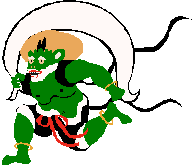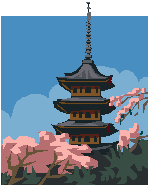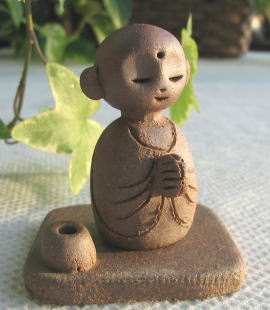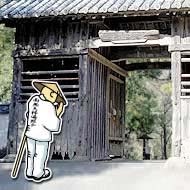
@@@@@@@@@@@@@@@@@@@@@@@@@@@@@@Japanese
Many foreign visitors think Japanese
religions are too difficult to understand. They are confused by the way that
Shinto and Buddhism are so well harmonized in the Japanese way of life. They
seem to have a lot of questions about Japanese religions. The following are
some of the more common questions:
Can you
tell me the history of Japanese religions?
 There are two religions in Japan: Shinto and Buddhism. Shinto is the native
religion characterized by the worship of myriad deified natural spirits.
It originated from everyday life of the Japanese people in prehistoric
times and has long played an important role in Japanese society. Unlike
the worldfs major religions, Shinto has no fixed dogma, moral rules or
sacred scriptures. Perhaps for this reason, most Japanese quite easily
incorporate Shinto into their way of life together with Buddhism. There are two religions in Japan: Shinto and Buddhism. Shinto is the native
religion characterized by the worship of myriad deified natural spirits.
It originated from everyday life of the Japanese people in prehistoric
times and has long played an important role in Japanese society. Unlike
the worldfs major religions, Shinto has no fixed dogma, moral rules or
sacred scriptures. Perhaps for this reason, most Japanese quite easily
incorporate Shinto into their way of life together with Buddhism.
Buddhism originated in India and traveled through China and Korea to Japan
in the
mid-6th century. At first there was some dispute among ruling families over whether
to accept Buddhist teachings. But it was Prince Shotoku that accepted and
adopted Buddhism along with other aspects of Chinese culture. He established
several major monasteries such as Horyuji, near Nara. As the state religion,
Buddhism dominated Shinto, the indigenous religion, for over a millennium.
Buddhism was practiced mostly by the ruling classes until in the Heian
period (794-1185). In the Heian period Tendai and Shingon sects appeared,
then, Jodo, Jodoshinshu, Nichiren and Zen sects, etc. in the Kamakura period
(1185-1336), when Buddhism became more widespread. In the Edo Period (1603-1868),
when the parishioner system was adopted by the Tokugawa Shogunate, temples
were controlled and Buddhism emphasized ancestor worship including funerals
and memorial services.
During
the Meiji Restoration of 1868, the emperor was restored to the head of the government
and Shinto was established as the state religion. The emperor was considered
the divine descendant of the sun goddess Amaterasu Omikami. She was believed to
have presented Imperial Regalia to her grandson, who in turn passed them on to
his descendants, the emperors, the first of whom was Emperor Jimmu. This direct
lineage from the gods was reflected in a feeling of Japanese superiority, which
in turn fed the military expansion of the Japanese Empire. Shinto was
considered to be the official belief of the entire Japanese race and was embodied
in the huge number of shrines, large and small, throughout the country.
After World War U, the Allied
Occupation separated Shinto and the state and this break was written into the
new constitution. The emperor also issued a statement renouncing all claims to
divinity and the use of Shrine for nationalistic purposes was forbidden.
Well, what about a cabinet minister's continued visits to the Shrine?@
@ Visits by cabinet ministers to Yasukuni Shrine, which enshrine the war-dead,
are always protested as being provocative by Japanfs Asian wartime foes.
The problem is whether the ministerfs visit is a private or not. He can
visit the Shrine privately.
Ifm very confused to hear that the birth and wedding ceremonies of
most Japanese are Shinto, while funeral ceremonies are Buddhist. Do Japanese have
a religion ?
Japanese people are tolerant of all religious sects, because Shinto, the
indigenous religion of Japan, has no fixed dogma or sacred scriptures,
but has a lot of deities. This doesnft mean that many Japanese are totally
indifferent to any religion. In the troubled days of youth, they show their
interests in the philosophy of life, and as they become busier with their
work and with supporting their families, they move away from religion.
But in old age, they once again come back to religion. Japanese attitudes
to religion donft include a monotheistic god such as the God of Christianity.
Japanese people are not dogmatic but they sense that everything is transient
from events and natural phenomena around them. Their love is directed not
only to human beings but also to the whole universe. Japanese people often
say, gYou canft say what will happen tomorrow. Letfs lead a full life now.
To live well means to die well.h
How
can I distinguish temples and shrines?

If you find a gate that consists of two pillars joined by two crossbeams,
you are at a shrine. That gate is called gtoriih, and marks the entrance
to a sacred area. In front of the gtoriih, there is usually a pair of guardian
dogs called gkomai nuh. On the other hand, if you find a pagoda, you are in the precinct of
a temple. A pagoda was originally built to enshrine the holy relics of
Buddha nuh. On the other hand, if you find a pagoda, you are in the precinct of
a temple. A pagoda was originally built to enshrine the holy relics of
Buddha
On the other hand, if you find a pagoda,
you are in the precinct of a temple. A pagoda was originally built to enshrine the
holy relics of Buddha.
I
can see a stone statue, sometimes lined up in their dozens, at the edge of the
town or village or crossroads. What are they and why are some of them draped
with red bibs or baby hats?
 They are statues of gJizo Bosatsuh, who is
believed to be a guardian deity of children, pregnant women and travelers, and
they often appear in folktales as someone who brings good fortune to those who
are honest and kind. The red bibs and baby hats are offerings from the women
who have lost their children, either before or after birth, to console the
souls of their children. They are statues of gJizo Bosatsuh, who is
believed to be a guardian deity of children, pregnant women and travelers, and
they often appear in folktales as someone who brings good fortune to those who
are honest and kind. The red bibs and baby hats are offerings from the women
who have lost their children, either before or after birth, to console the
souls of their children.
In
Shikoku I saw a lot of pilgrims wearing the white clothing. Why are they
wearing the white clothing? Are they all making a pilgrimage for religious
reasons?
@
The
white clothing worn by the pilgrims represents purity and innocence. However, in
the past it also held the meaning of a death shroud, symbolizing that the
pilgrims were ready to die at any time. Some pilgrims receive temple stamps on
their extra vest. The vest becomes a family treasure and is later put on the
deceased before cremation. The motives for making pilgrimage are varied. For
example, some go for religious reasons, some to pray for healing, and safety at
home, or some in memory of those who have passed away. As well, some come just to get away from
regular life, some for recreation, or some to spend time alone in reflection
and to find oneself.
Some temples enshrine Shinto deity personified as a Buddhist statue.
Why? Moreover, the Buddhist Statue is different according to the temple. Is
there any hierarchy among Buddhist Statues?
In
the course of incorporating Shinto into Buddhism, various different deities
emerged. At the end of the 9th century, Hachiman Deity, for example, was
personified as figures of enlightened Buddhist priests. These are called Sogyo
Hachiman. However, the most common name of Buddha, meaning gan enlightened oneh
and holding the highest position of all statues, is Nyorai. The greatest Nyorai
is different according to the teachings of the Buddhist sects, but there is no
hierarchy. The roles of Nyorai are different.
EShaka Nyorai
@This
represents Shakamuni who at the end of training achieved enlightenment and
became a Nyorai. With encompassing power, this being can save all humankind.
This Nyorai is conceived to be the greatest within Zen teachings.
EAmida Nyorai
@ This Buddha lives forever and
the light it gives forth shines all @people throughout the world. Those who believe in Amida Nyorai and chant
a prayer to this Buddha will be able to go to the Land of Paradise. Within
the teachings of Jyodo and Jyodoshinshu sects, this figure is believed
to be the greatest.
EYakushi Nyorai
@This figure is
considered to be a Buddha of healing to whom people pray for cures from
sicknesses. This being holds a medicine jar in its left hand.
EDainichi Nyorai
@This Buddha has a crown on its head and other accessories and is said to
be a model of young Shakamuni. Within the teachings of Shingon sect, this
figure is considered to be the greatest Nyorai.
|


 nuh. On the other hand, if you find a pagoda, you are in the precinct of
a temple. A pagoda was originally built to enshrine the holy relics of
Buddha
nuh. On the other hand, if you find a pagoda, you are in the precinct of
a temple. A pagoda was originally built to enshrine the holy relics of
Buddha
